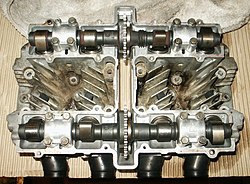Overhead camshaft
Overhead camshaft (OHC) valvetrain configurations place the camshaft within the cylinder heads, above the combustion chambers, and drive the valves or lifters directly instead of using pushrods. When compared directly with pushrod (or I-Head) systems with the same number of valves, the reciprocating components of the OHC system are fewer and in total will have less mass. Though the system that drives the cams may become more complex, most engine manufacturers easily accept the added complexity in trade for better engine performance and greater design flexibility. The OHC system can be driven using the same methods as an I-Head system, these methods may include using a timing belt, chain, or in less common cases, gears.
Many OHC engines today employ Variable Valve Timing and multiple valves to improve efficiency and power. OHC also inherently allows for greater engine speeds over comparable cam-in-block designs.
There are two overhead camshaft layouts:
- Single overhead camshaft (SOHC)
- Double overhead camshafts (DOHC)
Single overhead camshaft
Single overhead camshaft is a design in which one camshaft is placed within the cylinder head. In an inline engine this means there is one camshaft in the head, while in a V engine there are two camshafts: one per cylinder bank.
The SOHC design has less reciprocating mass than a comparable pushrod design. This can allow for higher engine speeds, which in turn will increase power output for a given torque. The cam operates the valves directly or through a rocker arm as opposed to overhead valve pushrod engines, which have tappets, long pushrods and rocker arms to transfer the movement of the lobes on the camshaft in the engine block to the valves in the cylinder head.
SOHC designs offer reduced complexity compared to pushrod designs when used for multivalve heads, in which each cylinder has more than two valves. An example of a SOHC design using shim and bucket valve adjustment was the engine installed in the Hillman Imp,(4 cylinder, 8 valve) a small early 1960's 2 door saloon car with a rear mounted alloy engine based on the 'Coventry Climax' FWMA race engines. Exhaust and inlet manifolds were both on the same side of the engine block, (thus not a crossflow cylinder head design).However this did offer excellent access to the spark plugs!
In the early 1980's Toyota and Volkswagen also used a directly actuated, SOHC parallel valve configuration with two valves for each cylinder. The Toyota system used hydraulic tappets while the Volkswagen system used bucket tappets with shims for valve lash adjustment. Of all valvetrain systems this is the least complex configuration possible.
Dual Overhead Camshafts

A dual overhead camshaft (also called DOHC, double overhead cam, dual overhead cam, or twin cam) valve train layout is characterized by two camshafts being located within the cylinder head, where there are separate camshafts for inlet and exhaust valves. Typical automotive engines equipped with dual overhead camshafts can have from two to four camshafts in total, depending on the engine configuration.
Double overhead camshafts are not required in order to have multiple inlet or exhaust valves, but are necessary for more than 2 valves that are directly actuated (though still usually via tappets). Not all DOHC engines are multivalve engines — DOHC was common in two valve per cylinder heads for decades before multivalve heads appeared, however today DOHC is synonymous with multi-valve heads, since almost all DOHC engines have between three and five valves per cylinder, such as in the Toyota Corolla AE86 (16 Valve) or the Toyota Levin BZ-G (20 Valve).
History
The first DOHC engines were two or four valve per cylinder designs from companies like Fiat (1912), Peugeot Grand Prix (1913,4 valve), Alfa Romeo GP - (1914, 4 valve), 6C- 1925, Maserati (Tipo 26, 1926) and Bugatti (Type 51, 1931). Most Ferraris used two valve per cylinder DOHC engines as well.
When DOHC technology was introduced in mainstream vehicles, it was common for the technology to be heavily advertised. While the technology was used at first in limited production and sports cars, the Fiat group is historically credited as the first car company to use a belt driven DOHC engine across their complete product line, comprised of coupes, sedans, convertibles and station wagons, in the mid-1960s.



No comments:
Post a Comment